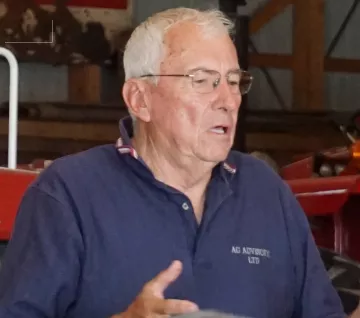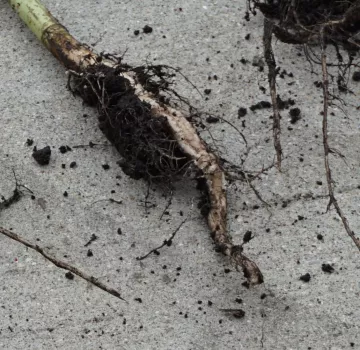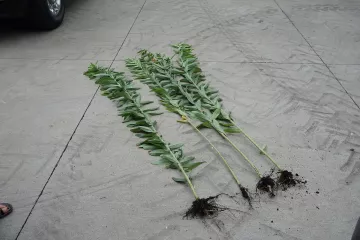by Pam Mackey Taylor
Dr. Michael McNeill, a soil scientist from Algona, has been working with landowners to restore the easement above the Dakota Access pipeline.
Soil is a living entity. When it is disturbed, soil can be killed. Dr. McNeill stated, “It is very easy to kill soil. Once it is dead, it takes a lot of work to bring it back alive. It will never be the same, but we can fix it.” Each farm on the pipeline route is different, in terms of soil types, land formation, and damage done by the pipeline construction. “There is no question that the compaction is severe,” declared McNeill.

For LaVerne Johnson’s farm, Dr. McNeill recommended that he plant sunn hemp, a legume that is not in the cannabis family. Sunn hemp has features that make it ideal to restore soil health. It has a big strong taproot. At 60-days of age, sunn hemp restores 150 pounds of nitrogen into the soil. It will grow 16 to 18 feet tall. Plowed under, the sunn hemp adds organic material to the soil. The protein and energy in sunn hemp feeds the soil microbes.
Sunn hemp normally has a 30-inch root that grows straight downward. When several plants were pulled from the stand of sunn hemp growing on Johnson’s pipeline easement, the plants had roots about 6 inches long. Some of the plants had roots that curved where they attempted to grow around compacted clods of dirt. Other plants exhibited tap roots that split into two sections as they attempted to maneuver around compacted soil. According to Dr. McNeill, roots are unable to pass through soil at 300 pounds per square inch (psi). Once the roots hit that pressure, they will stop growing downward. The plants on Johnson’s easement were also stunted in height, reaching only 6 to 8 feet tall.
Dr. McNeill explained soil compaction using a slice of bread. If you take a fresh slice of bread and push down on the bread, all of the air holes will collapse – that is compaction. You cannot bring the bread back to its original height. If you use a fork or any other tool, you simply cannot fluff the bread back to its original state.
The air pockets in the soil hold moisture and oxygen. The microbes need the oxygen in order to live. Without oxygen in the soil, carbon dioxide builds up to toxic levels. Those same air pockets provide space for plant roots.

Not only did the Johnson easement have severe compaction, it also had mixed soil layers. When soil layers are mixed, the mineral balance changes. By changing the mineral, the microbes that grow in the soil change or die. The microbes are what make minerals available to the plants which affects the ability of the soil to successfully grow crops.
To make matters worse, compaction does not allow excess water to drain through the soil. That results in ponding.
Last year, Johnson attempted to use a ripper to decompact the soil on the easement. It was not enough to repair the soil.
Dr. McNeill could not predict how long Johnson will have to work on restoring the soil on the pipeline easement. However one year will not be adequate. Obviously this will require an investment financially in planting cover crops and in the loss of commercial crops.
An Agriculture Impact Mitigation Plan was designed by Dakota Access, and approved by the Iowa Utilities Board, to guide the construction work on farm fields and the requirements to return the land to a productive state. Given the information presented about the compaction on Johnson’s easement, I started thinking about the expert testimony presented at the Iowa Utilities Board hearing concerning the pipeline permit. Dakota Access relied on Aaron J. DeJoia’s expertise to discuss the Agriculture Impact Mitigation Plan. Wallace Taylor, attorney for the Sierra Club, questioned DeJoia in the testimony below:
Q. On page 6 of your testimony, starting on line 10, you say, "Once the trench line soil is
replaced, the subsoil will be decompacted to 18 inches or to a little less than the depth of the
drain tiles, as to not compromise the drain tile integrity."
A. Yes.
Q. How will the subsoil be decompacted?
A. As I believe is written in the AIMP of Dakota Access, the subsoil will be decompacted using mechanical methods.
Q. What are those methods specifically?
A. Most of the time those will be using a deep ripper.
Q. And why was 18 inches chosen as the maximum?
A. Eighteen inches meets or exceeds the Chapter 9 rules for Iowa. Can I say one more thing on that?
Q. Sure.
A. Also the depth of 36 inches has been shown, so if you have 12 inches above that, you'd be in that 30- to 36-inch depth, which has shown to restore full productivity of corn on disturbed lands.
Q. And would you agree that decompaction is probably the most critical aspect of the restoration process?
A. In my experience, yes, it is.
Testimony is from Iowa Utilities Board hearing, November 18, 2015, pages 853 to 854.

So, if all of the promised decompaction was performed, why is Mr. Johnson’s easement so heavily compacted?
The Iowa Utilities Board (IUB) needs to get involved in working with the landowners in restoring the health of the soil in the easement. The IUB needs to make Dakota Access responsible for the restoration effort.